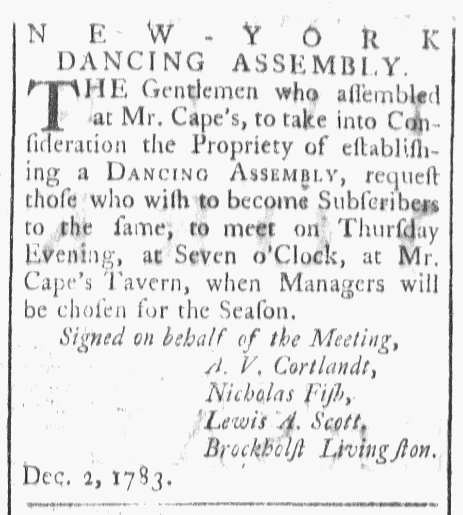in New York City
before the American Revolution. In the
of the Dutchess County Historical Society, William S. Thomas mistakenly identifies "John Livingston and his brother Henry" on Moore's list as the Reformed Dutch minister
and his younger brother Henry Livingston, Jr. of Poughkeepsie.
On Saturday nights in wintertime members of the Social Club would party at Queen's Head Tavern, operated after 1770 by Samuel Fraunces. In the summer they met at a private clubhouse on Kip's Bay. Rev. John H. Livingston, whose "piety was all-pervading," I'm guessing would have devoted Saturday nights to preparing his sermon for the next day. He definitely
hated theaters, and presumably avoided taverns and tavern sins when he could. As a distinguished clergyman, and the husband of Sarah Livingston (daughter of Philip Livingston, a signer of the Declaration of Independence), Dr. John H. Livingston did make it onto Mrs. Jay's
Dinner and Supper List for 1787 and 1788. As James Grant Wilson remarks,
"The doctor's tall and dignified figure and high breeding would make him a notable addition to any company…." --The Memorial History of the City of New York
John Henry Livingston belonged to that larger group of notables by virtue of his high status in the Dutch Reformed Church, and
marriage to Sarah Livingston his second cousin. According to Walter Stahr,
Sarah's dinner and supper list suggests that they hosted more than two hundred different people in 1787 and 1788. --John Jay: Founding Father
But William S. Thomas in his 1919 article misrepresents the more exclusive membership list of the Social Club as John Moore recollected it decades later. Moore named loyalists and "disaffected" rebels together on his list of Social Club members.
During his early manhood he was a frequent sojourner in New York City and, with his brother, the Rev. John H. Livingston, pastor of the Middle Dutch Church there, belonged to the Social Club. Their names appear in a list of its members who were dropped by the ruling Loyalist majority at the outbreak of the Revolution. Opposite the names of the Livingston brothers appears the entry, "Disaffected, but of no political importance." A Tory social club was no place for Henry Livingston.... --William S. Thomas on "Henry Livingston," 1919 Yearbook Dutchess County Historical Society; also available on the Henry Livingston by Dr. William S. Thomas page of Mary S. Van Deusen's personal website.
Contrary to the claim by Thomas that patriots like Henry Livingston
"were dropped by the ruling Loyalist majority," the whole Social Club
had to disband after 1775. Nobody was purged from the Social Club for his politics in the tyrannical manner that Thomas imagines. Their winter meeting-place was well known as "the resort of both Whig and Loyalist." Indeed,
Fraunces Tavern served the best Madeira to "some of the most active and distinguished men of the revolution." Those "disaffected" Whigs were the Social Club, which could not exist without them.
As a tavern it was the most noted in New-York, and was the resort of the bloods of that day who formed themselves into social clubs, and among whom were some of the most active and distinguished men of the revolution.... During the troubles which preceded the Revolution, Fraunces' Tavern seems to have been the resort of both Whig and Loyalist, political affairs not having sufficient power to sever the social ties of those whose custom it was to assemble there and discuss his Madeira, a wine, the excellent quality of which Sam's cellar stood proverbial. It must not be presumed that Sam was an idle spectator of the events then passing around him, his sympathies were with the Whigs, and he became one of Washington's most faithful friends and followers. New York Daily Tribune, 20 July 1854.
<http://chroniclingamerica.loc.gov/lccn/sn83030213/1854-07-20/ed-1/seq-3/>
Henry Livingston, Jr. of Poughkeepsie was a country cousin of the more privileged landowners, merchants, and lawyers in John Jay's Social Club. As a (relatively) humble Poughkeepsie farmer descended from Gilbert Livingston, the youngest and least fortunate son of Robert Livingston, this Henry was never really one of the "bloods" who gathered at Fraunces's Tavern. Thomas helpfully distinguishes
his Henry, Major Henry Livingston Jr., from Henry Alexander Livingston (the Major's better-remembered nephew, only child of Dr. John Henry Livingston and Sarah) and Henry Beekman Livingston. But in his eagerness to magnify Henry Jr. of Poughkeepsie and make him author of The Night Before Christmas, William S. Thomas overlooked the lordly Livingstons of Livingston Manor, in particular John and Henry.
As Cynthia A. Kierner relates in T
raders and Gentlefolk: The
Livingstons of New York, 1675-1790 (Cornell University Press, 1992), the
John and Henry Livingston named as members of the elite Social Club in
New York City were in fact sons of Robert Livingston, Jr. the 3rd Lord
of upper Livingston Manor:
Another
group, the Social Club, gathered many of the city's leading me for
evenings of drinking and conversation. In 1751, after he took up
residence at the Manor, Robert Livingston, Jr. joined the Social Club so
that when he visited New York City he could enjoy "a Gentle
Bacchanalion Engagement" with the friends he had left behind there.
Later, the Social Club's membership also included Robert's two youngest
sons, as well as their Clermont kinsman, Robert R. Livingston, Jr. --Traders and Gentlefolk
Citing Kierner, John L. Brooke in
Columbia Rising also identifies John and Henry of the NYC Social Club as "Upper Manor" Livingstons. Likewise, footnotes in
The Selected Papers of John Jay 1760-1779 edited by
Elizabeth Miles Nuxoll,
Mary A. Y. Gallagher, and
Jennifer E. Steenshorne (University of Virginia Press, 2010) explain the entries for "John Livingston and his brother Henry" on Moore's list of Social Club members as references to
"John Livingston (1749-1822), son of Robert Livingston, third proprietor of Livingston Manor."
and
"Henry Livingston (1752-1823), son of Robert Livingston, third proprietor of Livingston Manor."
The admirably progressive editors of
Selected Papers of John Jay say "
proprietor of Livingston Manor," preferring not to call any fellow mortal "Lord." Titles aside, they agree here with Richard B. Morris in
John Jay: The Making of A Revolutionary (Harper and Row, 1975) who identifies John and Henry as Livingstons of Livingston Manor:
John
Livingston (1749-1822) and his brother Hendrick (1752-1823) were sons
of Robert Livingston (1708-90), third lord of Livingston Manor.
On the Henry Livingston, Jr website, Mary S. Van Deusen makes Henry Jr. and his brother the Rev. John H. Livingston members of the Social Club, following William S. Thomas and repeating some of his errors:
- http://www.henrylivingston.com/prominentfamilyconnections.htm
Besides making Rev. John Henry Livingston and Henry Jr. of Poughkeepsie members of the New York City Social Club, William Sturgis Thomas and Mary S. Van Deusen have Henry Livingston, Jr. of Poughkeepsie serving in October 1774 as co-manager of the New York Dancing Assembly with John Jay and John Watts, Jr.
 |
New-York Gazette and Weekly Mercury - October 24, 1774
via GenealogyBank |
Henry Livingston, JUNIOR (whose father Henry Livingston was alive and well, age 60, in Poughkeepsie) was a farmer in 1774, married in May to Sarah "Sally" Welles of Stamford, Connecticut.
The "Henry Livingston" named in 1774 as co-manager of the Dancing Assembly in New York City must have been a different Henry, not the farmer from Poughkeepsie. A more likely Henry is again Henry Livingston of Livingston Manor, ever a bachelor. Or could this Henry Livingston be Princeton grad, teen-aged
Henry Brockholst Livingston, before he
dropped the "Henry"? This Henry was the brother of Jay's wife
Sarah Van Brugh Livingston. Henry Brockholst Livingston went to Spain with his sister and brother-in-law, serving a troublesome stint there as Jay's secretary. In December 1783, Henry Brockholst Livingston joined a controversial effort to revive the
Dancing Assembly, meeting with A. V. Cortlandt, Nicholas Fish, and Lewis A. Scott at Cape's City Tavern.
 |
Rivington's New-York Gazette - December 3, 1783
via GenealogyBank |
As revealed in one extant letter from
John Jay to Egbert Benson, Jay admired Henry Livingston Jr.'s first wife Sarah (Sally) Welles as "an excellent woman" and "
rara avis in terra":
Harry Livingston, I imagine, lives in the neighbourhood. His wife is an excellent woman, and in my opinion a rara avis in terra. I believe they both wish me well, and would not refuse to oblige me by taking my son to live with them and treating him as they do their own. In that family he would neither see nor be indulged in immoralities, and he might every day or two spend some hours with his grandfather, and go to school with Harry’s children; or otherwise as you may think proper. At any rate he must not live with his grandfather, to whom he would in that case be as much trouble as satisfaction. This is a point on which I am decided, and therefore write in very express and positive terms. Unless objections strike you that I neither know or think of, be so kind as to speak to Mr. and Mrs. Livingston about it. I will cheerfully pay them whatever you may think proper, and I would rather that you should agree to a generous allowance than a mere adequate compensation.... --John Jay, The Correspondence and Public Papers of John Jay, ed. Henry P. Johnston, A.M. (New York: G.P. Putnam’s Sons, 1890-93). Vol. 2 (1781-1782). 5/14/2018. http://oll.libertyfund.org/titles/2328#Jay_1530-02_633
From Madrid in 1781 Jay seems to have regarded Harry and Sally of Poughkeepsie as good folks whom he could pay to care for his son Peter while he was serving as ambassador to Spain. Jay fancied his son might attend school with Harry's children. After his wife Sally's death in 1783, Henry Livingston, Jr. boarded his own children elsewhere, according to
Day-Book entries in 1784, transcribed by Mary S. Van Deusen on the
Henry Livingston website. Jay's father moved from Fishkill to Poughkeepsie before his death in 1782 but
Where the Jays lived while in Poughkeepsie does not transpire. --J. Wilson Poucher, Yearbook of the Dutchess County Historical Society
Below, the 1823 obituary for Henry Livingston of upper Livingston Manor, the bachelor "General":
 |
| New York National Advocate - June 5, 1823 |






No comments:
Post a Comment